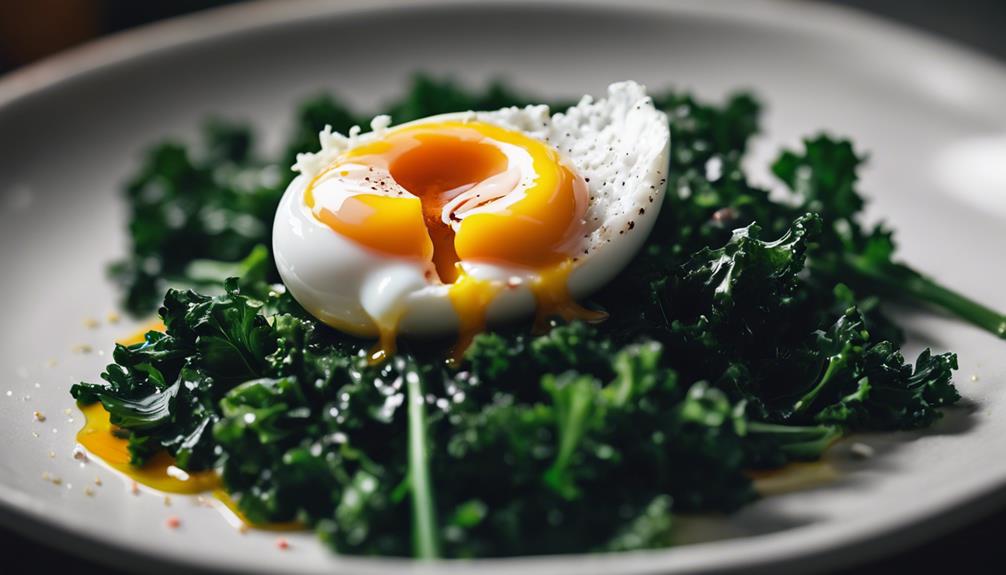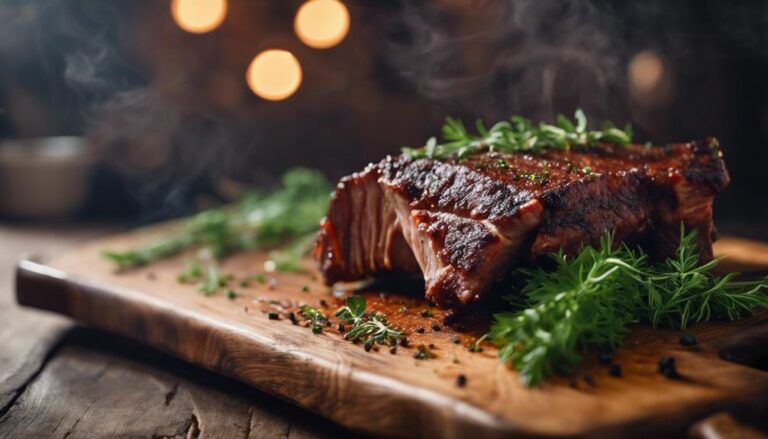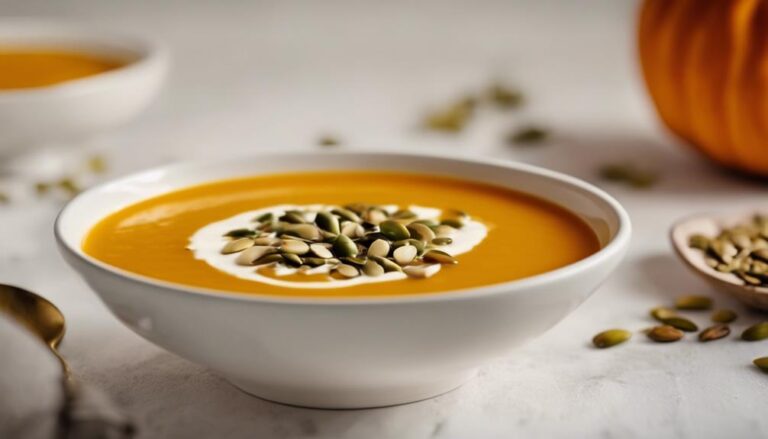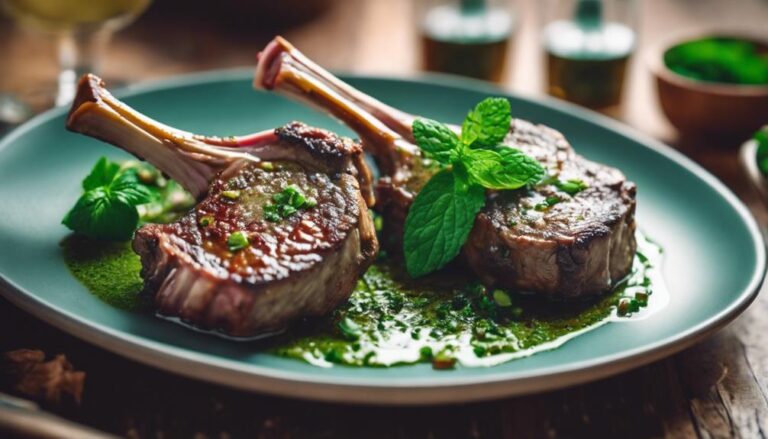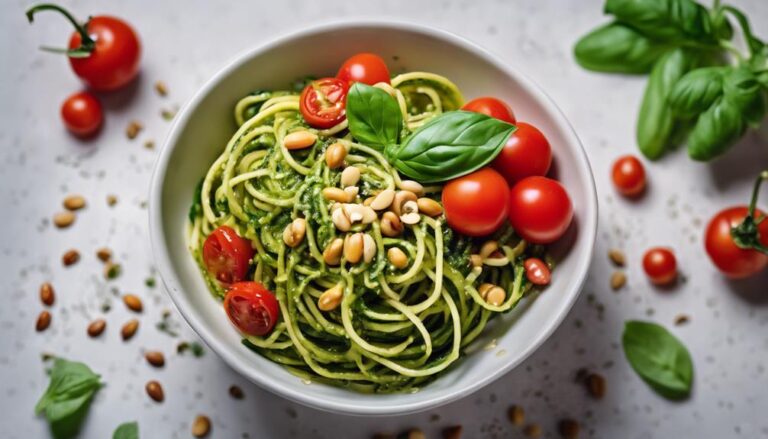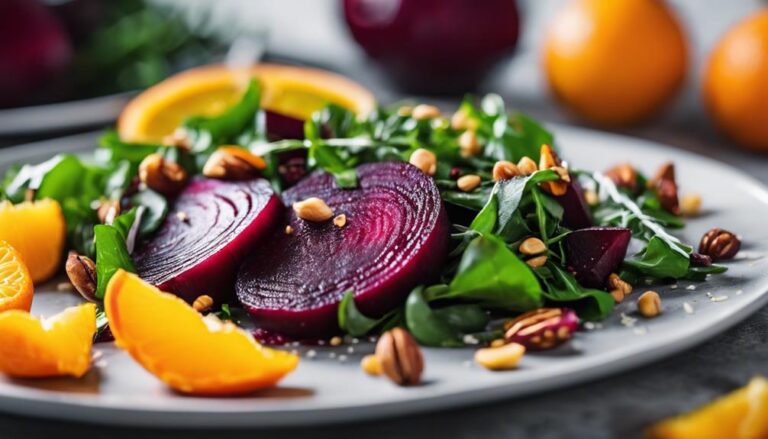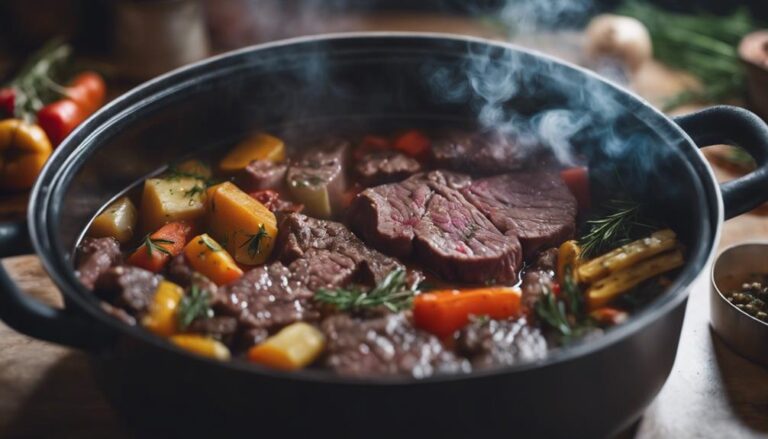Sous Vide Garlic Kale and Poached Eggs
Elevate your breakfast game with sous vide garlic kale and poached eggs. Infuse kale with garlic for a flavorful twist. Sous vide guarantees precise temperature control, producing perfectly poached eggs with velvety yolks. Cook kale at 167°F for ideal texture. Seal eggs individually to prevent spreading and cook uniformly for 45-50 minutes. Experiment with different variations like kale and bacon for unique flavors. Fresh eggs are key for the best outcome. Adding vinegar aids in coagulation. Maintaining a constant temperature guarantees runny yolks. Discover the perfect balance of flavors and textures in this culinary masterpiece.
What You Will Learn Here
- Sous vide method ensures precise temperature control for perfectly cooked poached eggs.
- Infuse garlic into kale for enhanced flavor and aroma.
- Maintaining 167°F water temperature yields runny yolks and velvety textures.
- Olive oil adds depth to garlic-infused kale, complementing the poached eggs.
- Sous vide cooking preserves nutrients in kale and delicate textures in poached eggs.
Origin of Poached Eggs
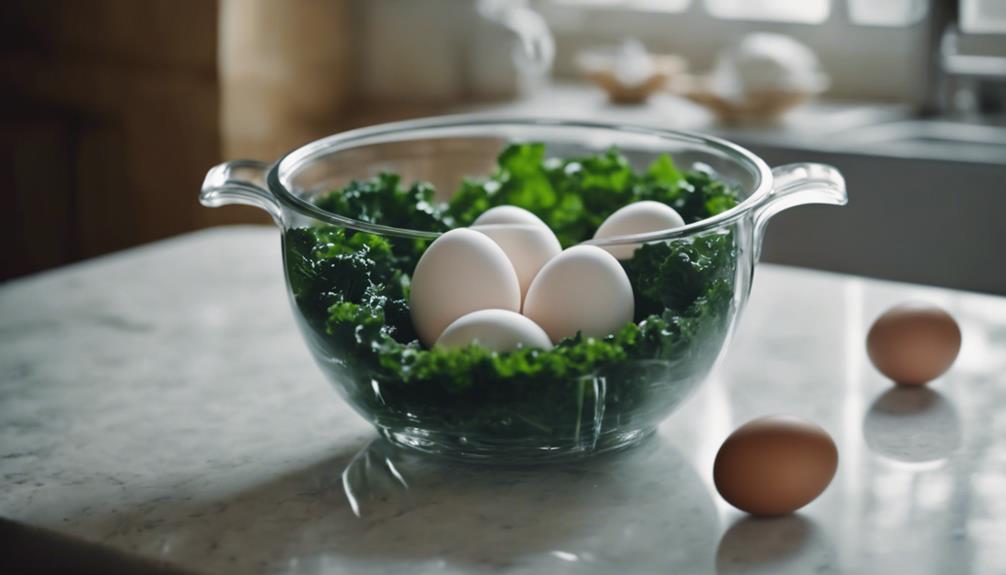
Poached eggs have a rich history dating back to medieval Europe, where they were delicately cooked in simmering water.
The term 'poach' originating from Old French 'pocher' reflects the gentle encapsulation of the egg during cooking.
Understanding the traditional methods and modern techniques of poaching eggs can elevate your culinary skills and enhance your breakfast experience.
Egg Poaching History
With origins dating back to ancient Rome, the delicate cooking method of encasing eggs in simmering water or broth has evolved into the popular culinary practice known as egg poaching. Poached eggs were considered a delicacy in ancient Rome, and the term 'poach' originates from the Old French word 'pocher,' meaning to enclose or bag, reflecting the gentle cooking process. The tradition of poaching eggs without their shells is believed to have started in France before spreading across Europe. By the 19th century, poached eggs had gained significant popularity and are now a staple in cuisines worldwide.
| Egg Poaching History | Facts |
|---|---|
| Ancient Rome | Delicate cooking method |
| Old French 'pocher' | Meaning to enclose or bag |
| France | Origin of poaching eggs |
| 19th Century | Popularity of poached eggs |
Traditional Poaching Methods
Tracing back to ancient culinary practices, the method of gently simmering eggs in water without their shells has been a hallmark of traditional poaching techniques. Poached eggs have roots in ancient Roman cuisine, where they were considered a delicacy.
Compared to frying or scrambling, poaching is a healthier option as it requires no added fats. The versatility of poached eggs makes them a popular choice, whether served alone, on toast, salads, or as a topping for various dishes.
Traditional poaching methods often involve the addition of vinegar or swirling water to aid in coagulating the egg whites and maintaining their shape. Mastering these traditional techniques guarantees perfectly poached eggs every time, ready to delight the taste buds of those you serve.
Modern Poaching Techniques
Modern culinary advancements have redefined the art of egg poaching, introducing innovative techniques that guarantee precise results and consistent quality. One of the most notable advancements in modern poaching methods is the use of sous vide cooking. Sous vide cooking involves vacuum-sealing food in a bag and cooking it in a water bath at a specific temperature for an extended period to achieve precise doneness. This method has revolutionized poaching by allowing chefs to maintain precise temperature control throughout the cooking process, resulting in perfectly poached eggs every time. The table below illustrates the benefits of using sous vide for poaching eggs:
| Benefits of Sous Vide Poaching |
|---|
| Precise Temperature Control |
| Consistent Results |
| Enhanced Flavor |
| Retained Nutritional Value |
| Minimal Hands-On Attention |
Egg Poaching Techniques
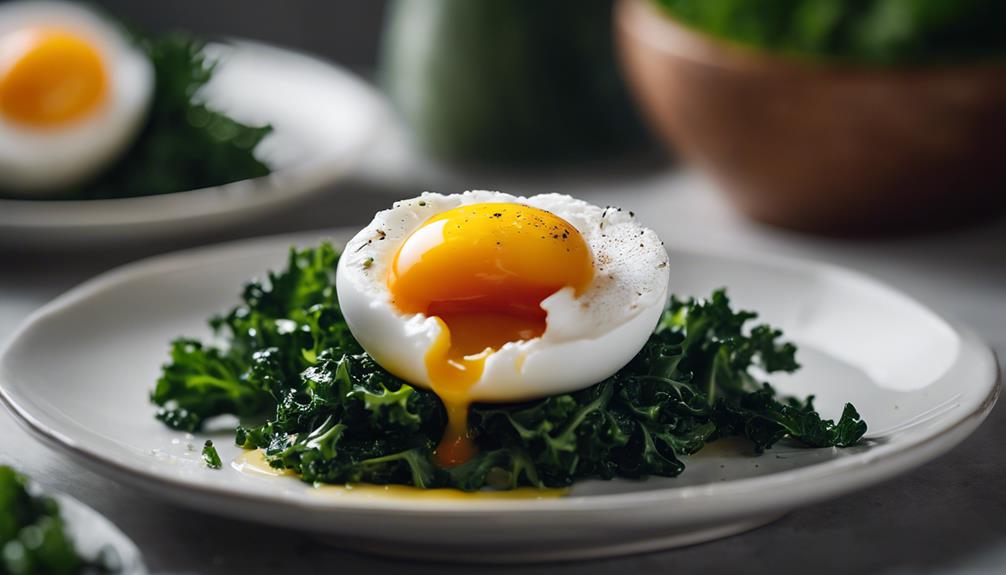
For achieving consistently perfect poached eggs with precise temperature control, consider utilizing the sous vide cooking method. When it comes to egg poaching techniques, the sous vide approach offers a foolproof way to achieve the desired results every time.
Here are some key tips to master the art of poaching eggs using sous vide:
- Set the water bath temperature to 167°F for runny yolks and firm whites.
- Crack the eggs into individual pouches to prevent them from spreading in the water.
- Make sure the eggs are fully submerged in the water bath to cook evenly.
- Poach the eggs for 45-50 minutes for the perfect consistency.
- Once cooked, gently remove the eggs from the pouches and serve them immediately for a delightful experience.
Eggcellent Poached Egg Variations
You can elevate your poached egg game by trying out different variations like the Kale and Black Garlic Twist, the Kale and Bacon Infusion, or the Kale and Tomato Fusion. These inventive combinations bring unique flavors and textures to the classic poached egg dish, allowing you to experiment and find your favorite twist.
Kale and Black Garlic Twist
When crafting Eggcellent Poached Egg Variations with a Kale and Black Garlic Twist, consider the harmonious blend of earthy kale and sweet, molasses-like black garlic flavors. Here are some tips to elevate your poached eggs with this unique twist:
- Use Fresh Kale: Opt for fresh kale leaves, removing the tough stems for a tender bite.
- Infuse Black Garlic: Mince black garlic and infuse it into the poaching liquid for a subtle yet distinctive taste.
- Control Poaching Time: Poach the eggs just until the whites are set but the yolks remain runny for that perfect texture.
- Balance Flavors: Adjust the amount of black garlic to balance its sweetness with the bitterness of kale.
- Garnish Thoughtfully: Finish with a sprinkle of chopped black garlic for an extra burst of flavor.
Enjoy the delightful combination of flavors in this unique twist on poached eggs!
Kale and Bacon Infusion
Enhance your poached egg experience with a tantalizing blend of kale and bacon infusion in this Eggcellent variation. Incorporating kale and bacon into your poached eggs offers a delightful twist on traditional flavors. Here are some reasons why this combination is a must-try:
- Kale brings a nutritious element to your dish, packed with vitamins and minerals.
- Bacon adds a savory and smoky flavor that complements the richness of the poached eggs.
- The combination of kale and bacon creates a satisfying texture contrast in each bite.
- The flavors from the bacon infuse into the kale, enhancing its taste profile.
- Poached eggs paired with kale and bacon infusion offer a well-rounded and flavorful breakfast option.
Kale and Tomato Fusion
Blending the earthy notes of kale with the vibrant sweetness of tomatoes creates a harmonious fusion in this Eggcellent poached egg variation. When you incorporate the kale into the mix, you're not only enhancing the flavors but also boosting the nutritional value of your dish.
Here are some key points to ponder:
- The kale brings a hearty texture and a dose of vitamins A, C, and K to the dish.
- Tomatoes add a burst of freshness and a rich source of antioxidants like lycopene.
- The combination of kale and tomatoes creates a colorful and visually appealing plate.
- This fusion is a versatile option that can be enjoyed at any time of day.
- The addition of poached eggs on top adds a creamy element that complements the kale and tomato fusion perfectly.
Egg Poaching Troubleshooting Guide
To troubleshoot egg poaching, verify that the water temperature falls within the ideal range of 167ºF / 75.0ºC, guaranteeing perfectly cooked eggs. Check the freshness of the eggs as older eggs may not hold their shape as well during the poaching process.
To achieve a runny yolk, adjust the cooking time based on personal preference and experimentation.
Perfect Poaching Temperature
For best results when poaching eggs, make sure the water temperature hovers between 160-180°F (71-82°C) to achieve the desired runny yolk and firm whites.
To maintain this perfect poaching temperature, using a sous vide immersion circulator is highly recommended. This device provides precise control over the water temperature, ensuring consistent and restaurant-quality poached eggs every time.
When poaching eggs at temperatures above 180°F (82°C), you risk overcooking the whites, resulting in a rubbery texture. Conversely, temperatures below 160°F (71°C) may lead to undercooked eggs.
Ensuring Egg Freshness
Ensuring the freshness of your eggs is a critical step in troubleshooting the poaching process for best results. Fresh eggs are essential as older eggs tend to spread out more in the water. To check the freshness, conduct the float test: fresh eggs sink and lie flat at the bottom, while older ones stand on one end or float.
Look for eggs with firm, tight whites and properly centered yolks for ideal poaching. Adding vinegar to the poaching water can help the eggs coagulate faster and maintain their shape. Before poaching, consider using a fine-mesh sieve to strain off any watery egg whites, ensuring a neater appearance when serving.
Achieving Runny Yolk
Achieve the desired velvety texture of a perfectly runny yolk by maintaining a constant water temperature of 167°F / 75.0°C when poaching eggs sous vide. This essential temperature control is vital for achieving consistent and desired egg textures.
The sous vide method allows for a gentle and gradual cooking process, ensuring that the egg whites don't overcook while resulting in a creamy yolk. Submerge sealed jars containing the egg mixture in the sous vide water bath for 35 minutes to achieve a velvety poached egg consistency.
This foolproof technique guarantees restaurant-quality poached eggs with perfectly runny yolks every time. Adding flavors like garlic to the poaching liquid can infuse the eggs with a subtle aroma, enhancing the overall dish.
Final Thoughts
What key takeaways can we gather from this exploration of Sous Vide Garlic Kale and Poached Eggs?
The use of olive oil to sauté the garlic-infused kale adds a depth of flavor and richness to the dish. This healthy fat not only enhances the taste but also aids in the guarantee of fat-soluble vitamins present in kale, making it a nutritious choice.
The precise temperature control offered by sous vide cooking ensures that the poached eggs are perfectly cooked with a silky, runny yolk every time, adding a luxurious touch to the dish.
By using the sous vide method, the nutrients in the kale are preserved, and the delicate texture of the poached eggs is maintained, resulting in a flavorful and visually appealing meal.
This recipe showcases the convenience and efficiency of sous vide cooking, offering a hands-off approach to creating a wholesome and satisfying dish.
Frequently Asked Questions
Can You Poach Eggs in a Sous Vide?
Yes, you can poach eggs in a sous vide machine. Set the temperature to around 167ºF for precise results. Using mason jars helps maintain shape. Sous vide desserts benefit from this controlled cooking method for consistent textures.
What Is the Best Temperature for Sous Vide Eggs?
To achieve perfectly cooked Sous Vide Eggs, set the temperature to around 147°F. This precise control guarantees a soft, runny yolk and fully cooked whites. Experimenting with different temperatures can help you find your ideal custard-like texture.
What Is the Difference Between Poached and Coddled Eggs?
When differentiating between poached and coddled eggs, remember that poached eggs are cooked directly in hot water for a firmer white and runny yolk, while coddled eggs are gently cooked in a container with butter or cream for a softer texture throughout.
How Do Chefs Make Perfect Poached Eggs?
To achieve perfect poached eggs, start with fresh eggs. Utilize the sous vide method for precise temperature control, ensuring even cooking. Gently cook the eggs in a water bath to reach desired doneness, resulting in consistently delicious poached eggs.
Conclusion
To sum up, mastering the art of poaching eggs can elevate any dish to a new level of sophistication.
By understanding the various techniques and troubleshooting tips, you can create perfectly poached eggs every time.
Whether you enjoy them on top of garlic kale or in a classic eggs benedict, the delicate texture and rich flavor of a poached egg will always impress your taste buds.
Keep experimenting and perfecting your poaching skills to become a true culinary pro.
